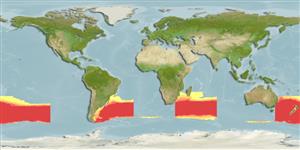Common names from other countries
>
Aulopiformes (Grinners) >
Paralepididae (Barracudinas)
Etymology: Magnisudis: Latin, magnus = large + Latin, sudis = esox, fish of the Rhine, cited by Plinius 9.15; it also means "stake" (Ref. 45335).
Environment: milieu / climate zone / depth range / distribution range
पारिस्थितिकी
समुद्री बैथीपिलाजिक; गहराई सीमा 0 - 1000 m (Ref. 4056), usually 300 - 800 m. Deep-water; 20°S - 60°S
Probably circumglobal in the Southern Ocean from about 20°S to Antarctica. Specimens south of the Antarctic Convergence probably expatriated.
आकार / वज़न / Age
Maturity: Lm ? range ? - ? cm
Max length : 55.0 cm TL पुल्लिंग / अलिंग; (Ref. 4056)
पृष्ठीय रीढ़ (सम्पूर्ण): 0; पृष्ठीय सौफट रेज़ (सम्पूर्ण): 9-11; गुदा कांटा 0; ऐनल सौफट रेज़: 22 - 25. Body pale with brownish dorsal band (Ref. 4056).
Vertically, juveniles occur from near surface to about 200 m and adults down to 1,000 m but mainly between 300-800 m. Feeds mainly on fishes.
Life cycle and mating behavior
परिपक्व अवधि | पुनरुत्पत्ति | मछलीऔ का अंडे देना | अंडे | Fecundity | लार्वा
Post, A., 1990. Paralepididae. p. 138-141. In O. Gon and P.C. Heemstra (eds.) Fishes of the Southern Ocean. J.L.B. Smith Institute of Ichthyology, Grahamstown, South Africa. (Ref. 5176)
IUCN Red List Status (Ref. 130435)
CITES (Ref. 128078)
Not Evaluated
Threat to humans
Harmless
Human uses
अधिक जानकारी
आम नामउपशब्दचपायचयपरभक्षीईकोटोकसीकोलौजीपुनरुत्पत्तिपरिपक्व अवधिमछलीऔ का अंडे देनाFecundityअंडेEgg development
संदर्भजलीयकृषिजलीयकृषि रूपरेखाखींचआनुवंशिकीElectrophoresesहैरेटिबिलटीबीमारीप्रक्रमणMass conversion
सहयोगीयोतस्वीरेStamps, Coins Misc.ध्वनिसिगुयटिरारफ्तारतैरने के प्रकारगिल क्षेत्रOtolithsदिमागदृष्टि
साधन
Special reports
Download XML
इंटरनेट स्रोत
Estimates based on models
Preferred temperature (Ref.
115969): 2.7 - 9.9, mean 6.8 (based on 393 cells).
Phylogenetic diversity index (Ref.
82804): PD
50 = 0.6250 [Uniqueness, from 0.5 = low to 2.0 = high].
Bayesian length-weight: a=0.00224 (0.00090 - 0.00555), b=3.14 (2.92 - 3.36), in cm Total Length, based on LWR estimates for this (Sub)family-body shape (Ref.
93245).
Trophic level (Ref.
69278): 4.5 ±0.80 se; based on food items.
Fishing Vulnerability (Ref.
59153): Moderate vulnerability (42 of 100).
